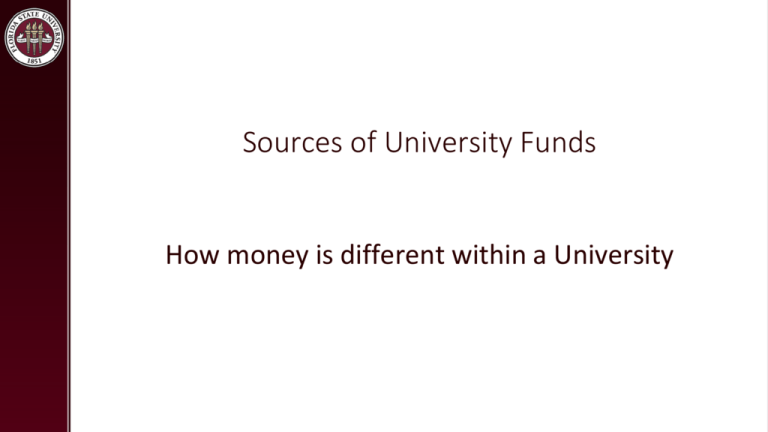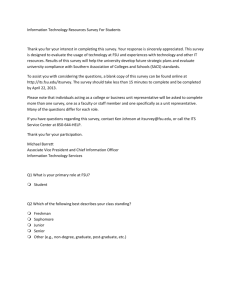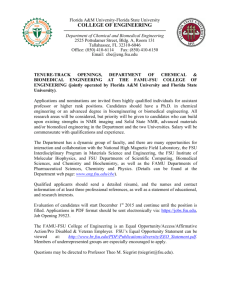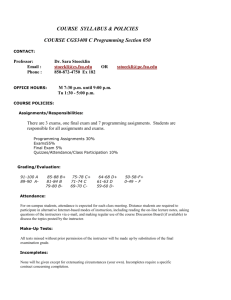Sources of University Funds
advertisement

Sources of University Funds How money is different within a University Presentation Outline • Types of money • Limitations and spending restrictions • Budget vs. Cash Types/Color of Money • Concessions (Vending) • Tuition Differential • Construction • Carry Forward • Sponsored Research • Auxiliaries • Research Foundation • Local Fees • Foundation • Athletics • Education & General Source – FSU Budget Office Education & General • E&G funds include General Revenue (primarily Florida’s Sales Tax), the Educational Enhancement Trust Fund (Lottery sales), and Student and Other Fees (tuition, out-of-state fees, and other miscellaneous fees). Tuition Differential • Tuition differential funds are generated through certain increases in tuition or fees • Allowable rate increases varies depending on the type of fee- full details can be found in this 2015 Florida statute • Have additional spending restrictions. Therefore, unique fund code (121) was established to assist with tracking expenses in OMNI • E.g., no funding graduate teaching assistants • Funds are allocated by the Provost Carry Forward • E&G funds remaining from the previous fiscal year are placed into a Carry Forward fund. • Some universities may sweep these, and/or “certify forward” obligated funds not spent in that fiscal year, as the State of Florida still practices. Auxiliaries • Auxiliaries are revenue generating business type activities that support the mission of the institution and provide essential services to the campus community. There are several different types of auxiliaries: • • • • • Enterprise Sales & Services of Educational Activities Sales & Services of Non-Educational Activities Materials & Supplies Fees Other • Examples: FSU-Card Center, Seminole Golf Course, Transportation Services, Telecommunications (now w/ ITS) Local Fees Fees paid by students in addition to tuition • Activity & Service Fee • Financial Aid Fee • Athletics Fee • Capital Improvement Fee • Health Fee • Transportation Fee • Technology Fee • Student Facility Use fee Concessions (Vending) • The concession funds are generated primarily from commissions made from the vending machines, and are then allocated by the President, Vice President, and then to the colleges/departments • Fewer restrictions on spending, see expenditure guidelines Construction Funds • PECO (Public Education Capital Outlay) fund • Private sources • State Matching • CITF (Capital Improvement Trust Fund) • PO&M (Plant Operation & Maintenance) Sponsored Research • This fund consists of grants, contracts, and other agreements between the University and government sponsors. Funds or monies may consist of federal, federal flow thru, state, not for profit organizations, and private sources. • Note: Formerly referred to as Contracts & Grants or C&G. Direct Support Organizations (DSOs) • Direct Support Organizations are non-profit organizations that operate exclusively to provide the University with additional resources from private gifts, or other sources. Direct Support Organizations (DSOs) • FSU Foundation • FSU Research Foundation • College of Business Student Investment Fund • Seminole Boosters • Family Medical Practice Plan • Ringling Museum Foundation • FSU Magnet Research and • International Programs Association • Alumni Associations • Financial Assistance • Performing Arts Center Foundation Development • FSU Real Estate Foundation FSU Research Foundation • This fund consists of grants, contracts, and other agreements between the University and private (non-government) sponsors. Funds or monies may consist of private corporations, non-profit organizations, and other private sources. FSU Foundation • The FSU Foundation organizes the fundraising activities and funds management for the university. As a DSO, it is a non-profit corporation, today manages an endowment of $370 million and has total assets of $498 million (per Audited Financial Statements as of June 30, 2012 LINK). • Types of funds include scholarships, graduate assistantships, endowed professorships, and general development funds. What can be purchased on what fund? • Controller’s Office Expenditure Guidelines • Controller’s Office > Accounts Payable > Expenditure Guidelines http://controller.vpfa.fsu.edu/ Budget vs. Cash • How they are different/similar based on the color of money? • E&G: Budget = “Cash” (available balance) • Non-E&G (Auxiliary): Budget ≠ Cash • Sponsored Project: Budget = Cash Spending Constraints • For E&G and non-E&G (excluding C&G and Construction) departments, “Budget Checking” in OMNI will prevent transactions from being processed without sufficient funds at the department-fund-account level. • Non-E&G departments must also have sufficient cash. These departments could spend into a cash deficit, as there is no “Cash Checking” in OMNI. • Note: Having sufficient budget (authority to spend) does not mean the department has sufficient cash. Rate vs. Salary • Rate: the annualized gross salary for a specific position • Salary: Rate plus fringe benefits • E&G: Department manages the budget for only the rate. • Auxiliary: Department manages the budget for salary (rate plus fringe) • Sponsored Research: Department manages the budget for salary (rate plus fringe) E&G Salary Budgets • No longer managed by the Budget Office outside of OMNI • Position Budgeting & Rate Management will soon be maintained in Hyperion • Budgets in OMNI will need to be adjusted as changes occur (e.g., pay increases, positions transferred between departments, etc.) • Handled by “School Managers,” (budget managers) who typically work in the Dean’s Office. WRAP UP & QUESTIONS Contact Information • Lauren Barrett– Quality Assurance • lmbarrett@fsu.edu • 645-8611 • Malica Segura– University Business Administrators • msegura@fsu.edu • 644-6972 • Slides available at: http://controller.vpfa.fsu.edu/training





